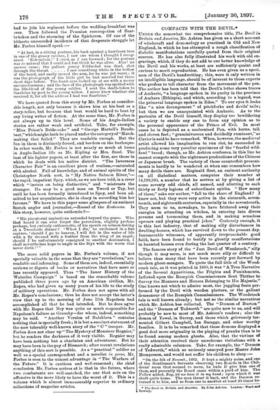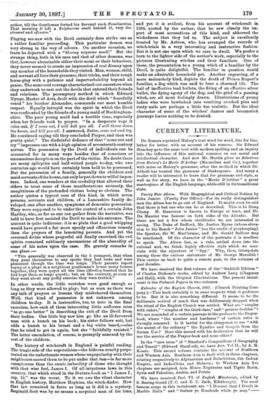COMPACTS WITH THE DEVIL.* UNDER the somewhat too comprehensive title,
The Devil is Britain and America, Mr. Ashton has given us a short account of witchcraft and demonology as practised in Old and New England, in which he has attempted a rough classification of diabolic manifestations carefully quoted from their original sources. He has also fully illustrated his work with old en- gravings, which, if they do not add to our better knowledge of the Devil and his works, at least are sufficiently quaint and curious to merit reproduction. He has even given us a speci- men of the Devil's handwriting; this, were it only written in an intelligible language, should be of interest to those experts who profess to tell character from the movement of the pen.
The author has been told that the Devil's letter shows traces of Amharic, "a language spoken in its purity in the province of Amhara (Ethiopia), and which, according to a legend, was the primeval language spoken in Eden." To our eyes it looks like "a nice derangement" of pitchforks and devils' tails ; but then we are unacquainted with Amharic. As to the portraits of the Devil himself, they display too bewildering a variety to enable any one to form any opinion as to the personal appearance of the Prince of Evil. In most cases he is depicted as a modernised Pan, with horns, tail, and cloven feet ; " graminivorous and decidedly ruminant," as Cuvier is said to have remarked. When, however, the medimval artist allowed his imagination to run riot, he succeeded in producing some very peculiar specimens of the "fearful wild- fowl" breed; though, as Mr. Ashton confesses, in this line he cannot compete with the nightmare productions of the Chinese or Japanese brush. The variety of these counterfeit present- ments is hardly to be wondered at when one remembers how many devils there are. Reginald Scot, an eminent authority on all diabolical matters, computes their number at 14,193,580, a number that he arrives at by giving a list of some seventy odd chiefs, all named, and allotting to each thirty or forty legions of subordinate spirits. "How many of these," asks our author, "fall to the share of England? I know not, but they were very active in the sixteenth, seven- teenth, and eighteenth centuries, especially in the seventeenth. They seem to us, nowadays, to have frittered away their energies in attending on witches, in entering into divers persons and tormenting them, and in making senseless uproars and playing practical jokes." Curiously enough, it is this last industry, that of making silly disturbances in dwelling-houses, which has survived down to the present day. Innumerable witnesses, of apparently irreproachable good faith, have been found to testify to ghostly manifestations in haunted houses even during the last quarter of a century.
The famous story of the "Just Devil of Woodstock," silly though it may seem, is not much more silly or difficult to believe than many that have been recently put forward by modern ghost-mongers. To quote the full title of the Wood- stock tale, as it was printed in 1660, it was "A True Narrative of the Several Apparitions, the Frights and Punishments, Inflicted upon the Rumpish Commissioners Sent Thither to Survey the Manners and Houses Belonging to His Majestie." One knows not which to admire most, the juggling feats per- formed by the Devil with wooden platters, or the gallant demeanour of the Rumpish Commissioners. The Woodstock tale is well known already ; but not so the similar narratives which Mr. Ashton has collected. The " Dcemon. of Burton" and the "Demon of Tedworth " are quite new to us, and will probably be new to most of Mr. Ashton's readers ; also the demon of Yowel, in Surrey, and those which grievously tor- mented Gilbert Campbell, Ian Smagge, and other worthy families. It is to be remarked that these demons displayed a good deal more originality in the playing of pranks than is to be found among modern ghosts. Also, that the victims of their attention received their unwelcome visitations with a really admirable calmness. Take, for example, the " Dcemon of Tedworth," which so seriously annoyed poor Master John Mompesson, and would not suffer his children to sleep
On the 5th of Novemb., 1662. it kept a mighty noise, and one of the Gentleman's Servants observing two Boards in the Chil- drens' room that seemed to move, he bade It give him one of them, and presently the Board came within a yard of hint. The Fellow added, Nay, let me have it in my hand ; upon which it was shuft quite home. The man thrust it back, and the Dcemon re- turned it to him, and so from one to another at least 20 times to- • The Breit in Britain and America. By Jam Ash ton. London Ward and Downey. zether, till the Gentleman forbad his Servant such Familiarities. That morning It left a Sulphurous smell behind It, very dis- pleasant and offensive."
Playing see-saw with the Devil certainly does strike one as
a rather familiar proceeding. This particular demon was very strong in the way of odours. On another occasion, we
learn he departed with a "bloomy noysome smell." But the strange thing, both in his case and that of other demons, was that, however abominable either their scent or their behaviour,
they never seemed to create an impression of real dismay upon any member of the households they visited. Man, woman, child, and servant all bore their presence, their tricks, and their rough horse-play with a patience and imperturbability beyond all praise. The same cool courage characterised our ancestors when they undertook to east out the devils that entered their friends and relations. The peremptory method in which Edward Nynge, Master of Arts, dealt with the devil which " feardally vexed" his brother Alexander, commands our most humble respect. Equally intrepid was the spirit in which the Devil was confronted by the friends of a young maid of Buckingham- shire. The poor young maid had a terrible time, especially
when her friends took to prayer. "In a desperate rage it cries out, If I come out, I will kill you all. I will throw down
the house, and kill you all. I answered, Satan, come out and try. He continued raging till they concluded Prayer, and then was pretty quiet." The disdainful defiance of that " come out and try "impresses one with a high opinion of seventeenth-century aerves. The possession by the Devil of individuals can be accounted for in many ways besides that of conscious or unconscious deception on the part of the victim. No doubt there are many epileptics and half-witted people to-day, who two centuries ago would have certainly been held to be possessed. But the possession of a family, generally the children and maid-servants of the house, can only be put down to wilful impos- ture. Indeed, one wonders at the credulity that allowed their elders to treat some of these manifestations seriously, the naughtiness of the pretended victims being so obvious. The author quotes a typical case of this kind, in which seven persons, servants and children, of a Lancashire family de- veloped, one after another, symptoms of demoniac possession. They were supposed to be under the control of a certain John Hartley, who, as far as one can gather from the narrative, was held to have first assisted the Devil to make his entrance. The account is quite ludicrous : it is so plain that a good whipping would have proved a far more speedy and efficacious remedy than the prayers of the lamenting parents. And yet the reverend divine whose prayerful aid finally exorcised the evil spirits remained sublimely unconscious of the absurdity of some of his notes upon the case. He gravely remarks in one place :—
"This generally was observed in the 5 youngest, that when they gene themselves to any spode they had mete and were pleasaunt though the time was longe. Their parents report beyng at a playe in a neighbour gentleman's house many houres together, they were quyet all the time (Hartley boested that he had kept them so longe quyet) ; but, on the contrary, as soon as they went about any godly exercise they were trebled."
En other words, the little wretches were good enough as long as they were allowed to play ; but as soon as there was any talk of prayers or lessons they misbehaved themselves. Well, that kind of possession is not unknown among shildren to-day. It is instructive, too, to note in the final exorcism, how each of these interesting little sufferers tries
"to go one better" in describing the exit of the Devil from their bodies. One little boy saw him go like an ill-favoured man with a hunch on his back ; his sister follows suit, but adds a hunch to his breast and a big white beard,—also that he tried to get in again, but she "faithfully resisted." The latter emendation, of course, is promptly annexed by the rest of the children.
The history of witchcraft in England is painful reading. The tragic side of the superstition—the hideous cruelty perpe- trated on the unfortunate women whose unpopularity with their tteighbours caused them to be put under that ban—is far more conspicuous than the comic imbecility of those who thought with that wise fool, James I. Of all iniquitous laws in this country, that which stood in the Statute-book as "1 James I, cap. 12," was the worst. To it we owe the vilest character In English history, Matthew Hopkins, the witch-finder. How that law remained in force as long as it did is a mystery. Reginald Scot was by no means a sceptical man of his time,
and yet it is evident, from his account of witchcraft in 1584, quoted by the author, that he saw clearly the im- port of most accusations of this kind, and abhorred the wickedness that they led to. The subject is excellently treated by Mr. Ashton, who has arranged the records of witch-trials in a very interesting and instructive fashion. Bat it is not one upon which we care to dwelL We prefer a turn to the lighter side of the author's work, especially to the pictures illustrating witches and their familiars. One of these, the presentation to a young witch of a familiar by the Devil, is quite delightful. The familiar in question would make an admirable household pet. Another engraving, of a more melancholy kind, depicts the death of Prince Rupert's familiar, a dog which was said to bear a charmed life. The hail of ineffective lead bullets, the firing of an effective silver bullet, the dying agony of the dog, and the grief of a passing witch, are all most feelingly drawn. Illustrations of young ladies who were bewitched into vomiting crooked pins and rusty nails are perhaps a little too realistic. But the ideal character of some of the witches' dances and broomstick journeys leaves nothing to be desired.



















































 Previous page
Previous page